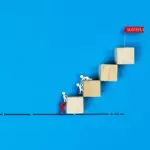Procurement, Purchasing, and Supply Chain Management Overview
The terms purchasing and procurement are often used interchangeably but have very different meanings. Both are related to supply chain management but play different parts in the process. For small companies, the responsibilities associated with purchases and procurement are usually carried out by one person, leading to the common confusion that they are the same. However, there are more people managing the supply chain and procure-to-pay cycle in large companies, so the labor is split into strategic and transactional activities.
You’ve dealt with all these terms before, but let’s do a quick refresher of the purchasing, procurement, and supply chain management definitions before we take a deep dive into each.
What is Supply Chain Management?
As you probably know, a supply chain includes every step in the process of turning raw material into a product and getting it to the customer. It encompasses sourcing and extracting raw materials, refining and manufacturing, assembly, sales, and distribution.
Supply chain management is, you guessed it, the act of managing a supply chain to make it operate as efficiently as possible. Mainly, it is overseeing suppliers and manufacturers to ensure they are maintaining the desired production quality and ethical business practices. Business ethics is becoming more scrutinized and as such, its role in supply chain management is increasing.
What is Procurement?
Procurement involves strategically sourcing and purchasing material and services from an external source. Procurement managers have to strategically source material, select goods, negotiate and manage vendors, approve purchase requests, and receive goods.
What is Purchasing?
Purchasing involves acquiring a good or service. It is how a procurement manager pays for something. Purchasing requires filling out spend requests and purchase orders, receiving goods and services, attaching packing slips to purchases, and passing completed purchases to the right team.
In general, procurement is long-term strategic planning and activities to get the goods you need, while purchasing is short-term transactional activities. Procurement managers will find a supplier, develop a relationship with the supplier, and negotiate a contract. After that, purchasing will place Purchase Orders and handle the daily issues related to the vendor like delivery and quality.
Purchasing and procurement both are a part of the procure-to-pay cycle. The procure-to-pay cycle includes all the steps a company needs to identify and get the goods and services it needs. Procurement is finding the goods you need, purchasing is buying the goods you need, and supply chain management is managing the overarching infrastructure in place to get the goods you need and get them to the customer.
Now that we have defined the differences between procurement, purchasing, and supply chain management, we can get into the importance of purchasing and procurement as well as the emerging technology improving the process.
What Importance Does Procurement Play in Supply Chain Management?
To better understand the procurement process, it can be broken up into steps:
- Define your business’ goods and services needs
- Submit a purchase request
- Evaluate and choose vendors and suppliers
- Negotiate terms and price
- Make a purchase order
- Inspect the goods you receive
- Compare purchase order with received receipts and invoice
- Approve invoice and pay
- Conduct record keeping
Procurement managers usually develop a relationship with vendors and suppliers after repeated purchases, allowing them to work in a mutually beneficial way. The process involves steps before, during, and after the purchase. The goal of procurement is to find the best product from the best vendor on the best terms.
For a profit, the cost of procuring the goods and services must be less than the amount you make selling the goods, subtracting the associated processing and selling costs. In this way, procurement directly impacts the company’s profits. Because procurement has such an important role in the business’s whole supply chain and its profitability, you should consider it a key part of your company strategy.
Specifically, procurement plays a role in your company identity, market placement, company capabilities, and management issues. Procurement managers must have a clear understanding of the organization’s needs and values in order to optimize their supply chain. Companies need the right people to reflect their company strategy and philosophy in their vendor relationships and negotiations.
Procurement managers are not involved with distribution decisions. They do not manage all of a company’s supply chain but they influence the profits by providing the company with the necessary materials and services in order to make and distribute the company’s products.
Need help negotiating with vendors and suppliers? Our operation experts are here for you!
What Importance Does Purchasing Play in Supply Chain Management?
The purchasing process can be broken into steps too:
- Acknowledge/make a purchase order
- Send a shipping notice
- Collect and file goods receipts
- Record invoices
- Compare purchase orders with receipts and invoice
- Pay the supplier
Purchasing is essentially a stage of the procurement process. However, purchasing, unlike procurement, isn’t dependent on your relationship with the individual vendors. That is to say for purchasing you should have routine best practices for all your suppliers. Purchasing is about the perfunctory parts of the relationship. If purchasing isn’t in place and transactions aren’t efficient, your relationships with vendors and your supply chain, in general, will suffer. Because of the importance of purchasing management in supply chain optimization, establishing and managing a proper system for purchasing in your company is necessary.
What Do Future Trends in Procurement, Purchasing, and Supply Chain Management Look Like?
As discussed in the beginning, the size of a company has a big impact on how it views and handles purchasing and procurement. Technology also plays a big role in how a company defines these terms and their associated responsibilities. Companies are transforming their supply chains with the help of technology, rapidly changing the procure-to-pay cycle. Globalization, more complex products, and more customer demand are the catalysts.
Primarily, companies are using technology to automate purchasing, the transactional part of supply chain management. Managing purchase orders has become a much easier task with advances in artificial intelligence, analytics, and supply chain interconnectivity. But, deploying these technologies in the purchasing process requires strategic planning in and of itself.
Purchasing can no longer be associated with only transactions and procurement with strategizing. Technology is making the act of purchasing a strategic endeavor as well. In fact, every part of supply chain management is becoming more data-driven and analytical.
As a business consulting agency with experience optimizing companies’ logistics, here are our two contenders for the most influential technology trends in procurement and purchasing:
The Internet of Things
The internet of things (IoT) is the term for the sensors, processors, software, and other data collection technology that exchanges information over the internet. For many companies, every step of the supply chain is being connected through the IoT and continuously communicating information. Goods, shipping containers, warehouse stations, shipping locations, and more are all being equipped with sensors and trackers.
The results of internet connectivity and sensors are more data collection, quicker data transfer, better risk analysis, and better process analyses for trends and optimizations. What this means for procurement and purchasing is that more suppliers can be evaluated and will provide better shipment data. Procuring and purchasing decisions can be more informed and optimized with the help of data collection and the IoT.
Artificial Intelligence
Once all the data is collected with the help of the IoT, it needs to be analyzed to find insights into your supply chain. This is where artificial intelligence (AI) and analytics come into play. Companies can utilize AI to look through the huge amounts of data they collect and quickly make predictions or identify trends. With this information, delivery times can be improved, warehouse operations automated, inventories better managed, and much more. It all boils down to how you see the data as useful.
AI and IoT, along with many other technological advances, are playing an increasingly important role in supply chains. You can read more about the supply chain technologies that are evolving the industry here.
AI and analytics will increase productivity in all steps of the supply chain. For procurement, strategic relationships can be better identified and optimized, and better purchases can be made. The best supplier for your business can be found and the shipping process can become more efficient, benefiting both you and the supplier. In-the-moment route changes that speed up delivery can be made and materials can be changed for better pricing and availability.
In order to stay competitive, companies need to keep up with these trends, and it is to their benefit. Procurement and purchasing software revolutionize the strategic decision-making that accompanies the process and makes record-keeping more efficient. Modern procurement methods utilizing technology can save you huge amounts of time and money. Despite the obvious value of data analytics for companies, supply chain managers often underestimate the skill and resources required to get value from their data.
Need help with data architecture and analytics? Our operation experts can help!
To Wrap It Up
Now that we have laid out the difference – and importance – between purchasing and procurement, where does that leave you? If you found the distinctions helpful and want to explore more, we are here to chat. You may even have the traditional modes of purchasing and procurement mastered, but now things like IoT and AI are being thrown into the mix…it all might feel like a little much.
Let us help you navigate the trends of the industry and quickly adapt your business to the ever-changing (and complex) technology that will inevitably make you more efficient and successful. You care about your business, and we care about helping.





